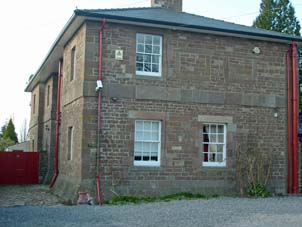Monmouth County Gaol facts for kids
Quick facts for kids Monmouth County Gaol |
|
|---|---|

The gatehouse to the former County Gaol
|
|
| General information | |
| Type | Prison |
| Town or city | Monmouth |
| Country | Wales |
| Coordinates | 51°49′1.3″N 2°42′48.9″W / 51.817028°N 2.713583°W |
| Construction started | 1788 |
| Completed | 1790 |
| Cost | £5,000 |
| Design and construction | |
| Architect | William Blackburn |
| Designations | Grade II listed |
The County Gaol was a large prison located in Monmouth, Wales. It opened in 1790 and was the main prison for the area known as Monmouthshire. People who broke the law were held here, and some very serious punishments took place until the 1850s. The prison was quite big, covering about an acre of land. It had a chapel, a place for sick prisoners (infirmary), living areas, and even a treadmill. The gaol closed in 1869. Most of the building was taken down in 1884. Today, only the gatehouse remains. This gatehouse is a special building, protected as a Grade II listed building. Inside the gatehouse, there is a colourful glass picture showing what the whole prison used to look like. It is also one of 24 important places on the Monmouth Heritage Trail.
Building the Gaol
The Monmouth County Gaol was designed by an architect named William Blackburn. It was built between 1788 and 1790. This prison was designed to be a "reformed" gaol. This means it followed new ideas from the first prison reformer, John Howard. He believed prisons should be more organised and cleaner.
The first person in charge, called the Governor, was James Baker. He earned £100 each year. The prison cost about £5,000 to build. The land was bought from Henry Somerset, 5th Duke of Beaufort. The gaol was made from local stone. About 18,000 tons of stone came from a quarry in Lower Redbrook.
Life Inside the Prison
Old pictures from the 1800s show how big and strong the gaol looked. It had high outer walls and an inner building with tall, round towers. People at the time said it looked more like a castle than a prison. It was praised for being well-planned and having fresh air in its rooms. They also noted how clean it was and how well the prisoners were looked after.
Food and Health
Prisoners who were held for debt (meaning they owed money) were given a bed, sheets, two blankets in winter, and a rug. They also received a special loaf of bread four times a year. This was thanks to a man from Monmouth who left money for this purpose.
However, the food for most prisoners was very poor. People who had committed serious crimes (felons) got only a small amount of bread each day. Debtors didn't get any food allowance at all. A prison reformer named John Howard noticed that many debtors survived on "water soup." This was just bread boiled in water.
The longer a prisoner stayed, the more food they were allowed. They might get extra oatmeal porridge for breakfast. They could also get some cooked meat and potatoes twice a week, and broth twice a week. But this diet often lacked important vitamins, like Vitamin C. This meant many long-term prisoners got sick with scurvy.
As late as 1851, a local newspaper called the Merlin wrote about the prison food. It said the diet was only oatmeal porridge, milk, and bread. Meat and vegetables were not allowed. The newspaper suggested that knowing how bad the food was would stop people from committing crimes.
But this poor diet made prisoners very weak. In 1853, a serious illness called typhus spread in the prison. Because the prisoners were so weak, they couldn't fight off the disease. Many became very sick, and at least one prisoner died.
Famous Prisoners
Three important leaders of the Chartist movement were held here. They were John Frost, Zephaniah Williams, and William Jones. They were put in the gaol after being found guilty of treason on January 16, 1840. Their original sentence was very severe. However, the Prime Minister at the time, Lord Melbourne, changed their punishment. Instead, they were sent away to Tasmania.
The Gaol Today
The old drawing of the gaol shows that the Gatehouse used to have castle-like walls and narrow openings for defence. The Gatehouse now has a sloped roof and windows, which were likely added after the prison closed in 1869. However, the large arched entrance is still there, even though it now has a normal front door.
The Monmouth County Gaol closed its doors in 1869. The prisoners were then moved to a new prison in Usk. Most of the main prison buildings were pulled down in 1884. The stone from the old prison was sold and used to build houses in Monmouth. It was also used at Sharpness Docks. The Cottage Hospital was built on part of the prison site between 1902 and 1903.
Today, the only part of the gaol that remains is the square gatehouse. It is made of Old Red Sandstone and has been changed into two private homes. The gatehouse became a Grade II listed building on August 15, 1974. It is one of 24 important buildings you can see on the Monmouth Heritage Trail.


